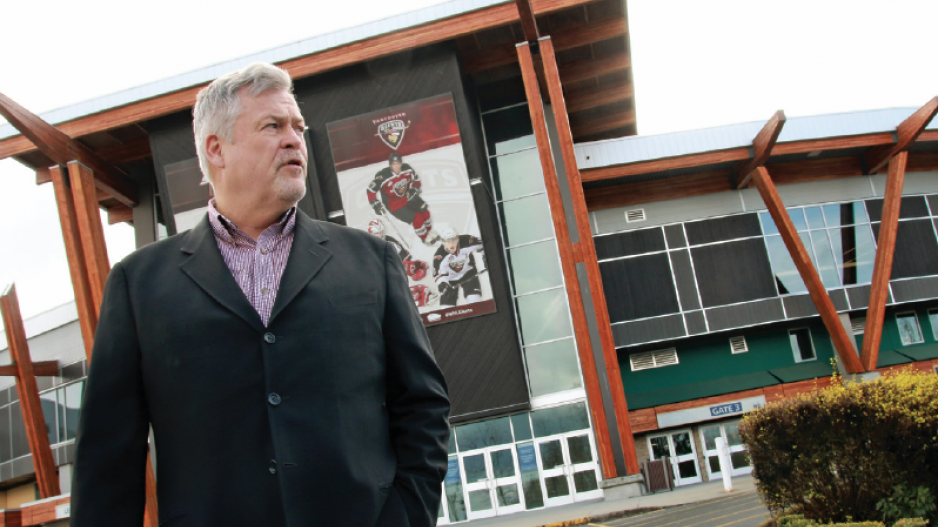While they’re still called the Vancouver Giants – and they have no intention of changing the name – the Lower Mainland’s only Western Hockey League franchise has definitely become Langley’s team.
Fan demographic surveys show a distinct shift in who’s heading to Giants games these days, following the team’s move from the Pacific Coliseum in East Vancouver to the Langley Events Centre for the start of the 2016-17 season. When Giants fans were surveyed back during the 2015-16 season, 62% of attendees were male. For the 2017-18 season, women represented 53% of ticket holders.
Dale Saip, senior vice-president of the Giants, said the team wasn’t expecting a gender switch to coincide with the move to Langley, but it is fully embracing it.
“It’s great for us, and I think it’s something that helps us,” he said. “Because moms are the ones who are making the decisions about where they buy their car insurance and where they buy their groceries, so the sponsors love it. But also it allows you to bill it as a family event, which is really important to us.”
Saip said the Giants can also probably credit their increased social media presence to the team’s bigger female fan base. From the 2015-16 to the 2017-18 season, the Giants’ following rose by 76% on Instagram, 32% on Twitter (NYSE:TWTR) and 23% on Facebook (Nasdaq:FB).
Township of Langley Mayor Jack Froese said the fan base change for the Giants is tied to the area’s real estate market, noting that a lot of families have moved into the community in the past few years from Vancouver looking for affordable homes.
“We’re certainly seeing that in Langley where newly developed areas are filling up with young families,” he said. “So the Giants become that affordable hockey option for them.”
Other fan demographics have also shifted with the move to Langley. During the 2015-16 season, 40% of fans were between the ages of 35 and 65. That has moved up to 45%, and there has also been an 11% jump in the number of fans in the 16-24 age group over the same period.
At the same time the fan base has evolved, it has also diminished in overall numbers. Attendance for Giants games has dropped from the 2015-16 season, when the team had an average of 3,848 fans per game, according to Canadian Hockey League statistics, to 3,383 for the 2017-18 season. The decline, however, is reflective of the entire Western Hockey League (WHL).
A high-water mark for the WHL was the 2012-13 season, when teams had an average of 4,815 fans per game. This number dropped to 4,474 for the 2016-17 season league-wide. Over the past two seasons, the Vancouver Canucks and the BC Lions have seen attendance numbers drop while the Vancouver Whitecaps have recorded a slight increase.
Saip said there are several factors affecting attendance, noting that when the Canucks are doing well, interest in hockey increases. The Canucks have missed the National Hockey League playoffs the last three seasons.
“Winning sells,” he said. “We love when the Canucks are really successful and are kings of the hill because when they’re king of the hill, we get to be crown prince. Because then we become the affordable version of the Canucks for families and sponsors.”
The Giants made the WHL playoffs last season, pushing the Victoria Royals to seven games before losing in Game 7 by one goal. Many pundits had predicted the team would not make the playoffs at all. Robert Gray, the national program director for TSN Radio, said expectations are high for the 2018-19 season, noting the Giants had one of the youngest teams in the WHL last season.
“Back in 2006 and 2007, the Giants had incredible teams, in ’07 winning a Memorial Cup,” Gray said. “As these junior teams are built for two-to-three-year winning cycles, it looks like [there are a] lot of good pieces in place already, and the Giants are not that far away from making a big impact again.”
Looking back on the move out of East Vancouver, Saip said the first taste the team got of the Langley Events Centre was back in 2010. During the 2010 Winter Olympics the Giants played six home games because the Coliseum was being used for short-track speedskating. Over the following few seasons the team could see the writing on the wall, especially as real estate prices around the area started to rise. He said young families, the team’s core fan base, were being pushed out to the Fraser Valley.
“And how do you replace those people? And that’s what we were finding in Vancouver, was that the people who could afford to go to our games were moving out to the [Fraser Valley] and maybe Burnaby. But you look at that affordability bump and it definitely got us thinking.”
Saip said Giants representatives had conversations with officials at the City of Vancouver, which owns the land and the building, about potential upgrades, but they fell on deaf ears. He added that the Coliseum, which has three times the capacity of the Langley Events Centre’s 5,276 seats, wasn’t creating the right type of fan experience for the modern age.
“There are 16,000 seats in the Coliseum so it can kind of feel cavernous,” he said. “And so it’s hard to create a winning atmosphere not just in the rink but from a broadcast perspective. We want that intimate yet big-league feel.” •




